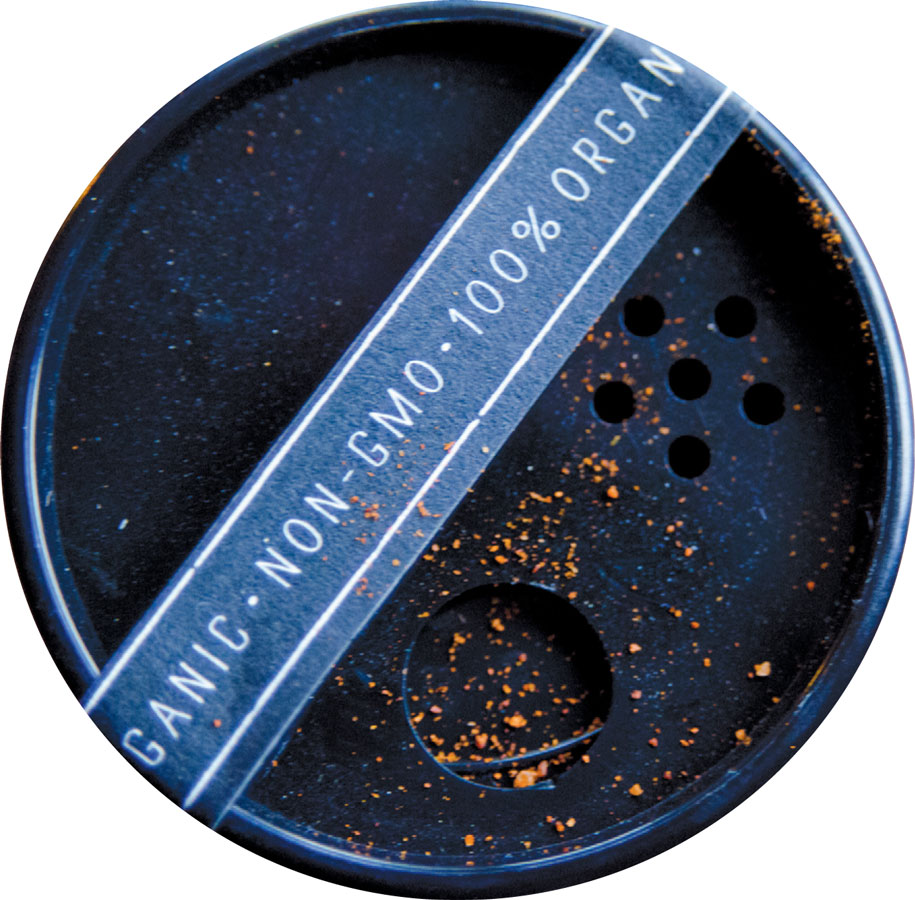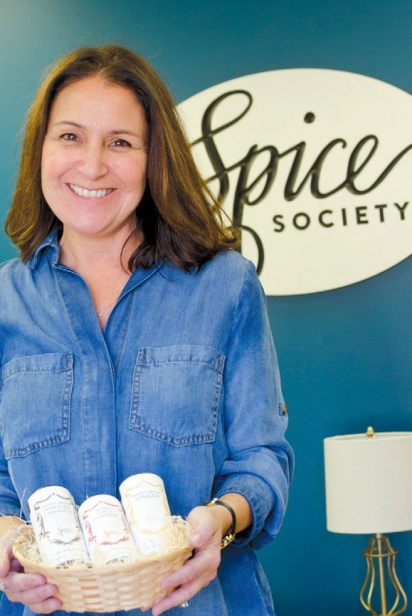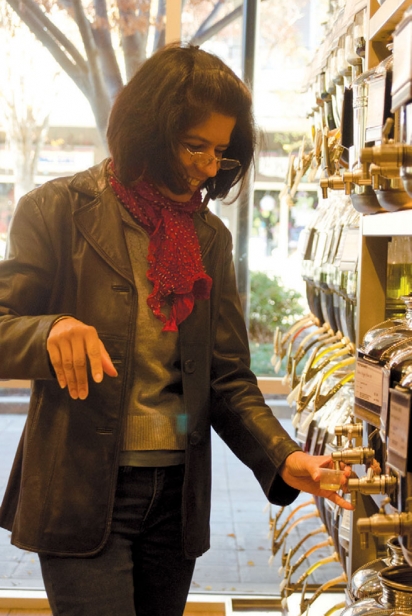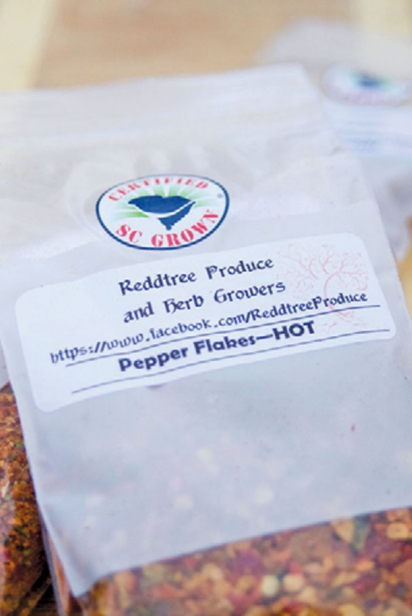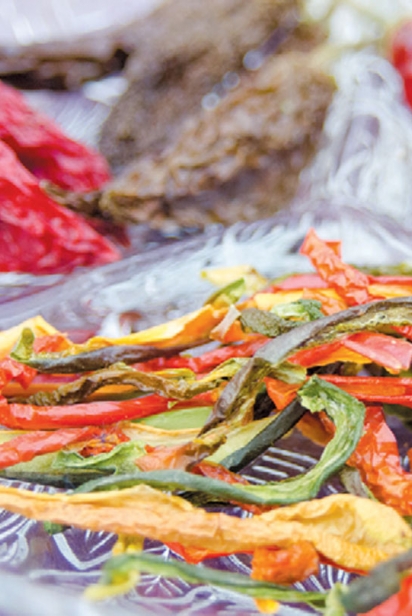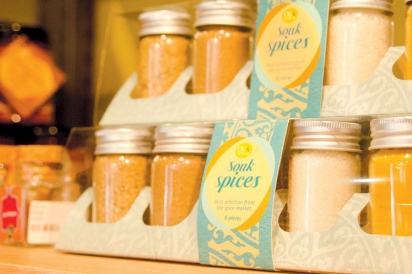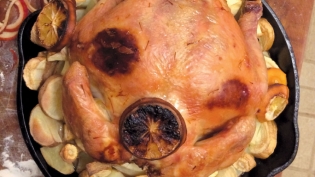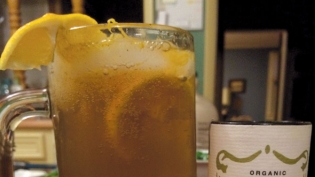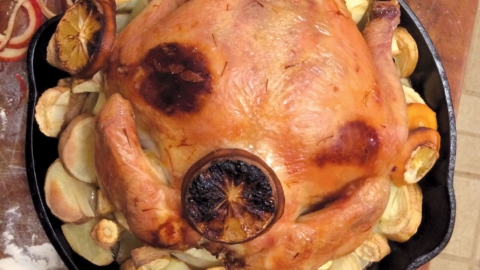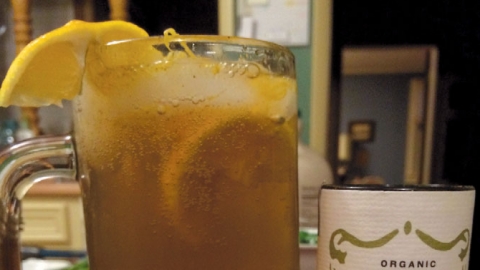Jewels of The Southern Kitchen
Sourcing Spices In South Carolina
Two days after Thanksgiving, my husband and I stood over the patch of fall-blooming saffron crocus in our front yard and plucked two brilliant threads to place on our tongues. Saffron’s subtle perfume is released by moisture so we waited for our taste buds to pick up its warm, distinctive presence. The spice portion of this already diminutive plant are the droopy stigmas, only three per flower, that could be easily overlooked if not for their flaring red coloration. Our micro-crop will only produce a “pinch” for a single recipe (about 20 threads), though the corms multiply each year. It’s easy to see why saffron (Crocus sativus) is the most expensive spice by weight, traded by humans for more than 3500 years. In spite of the fact that many exotic spices can be produced locally, they’re possibly the commodity that makes the most sense to import from afar (and then add to a dish of local groceries).
Spices are defined as flavoring agents that come from the non-leafy parts of plants—fruits, seeds, bark, stems, roots, flowers, any plant part that isn’t foliage. In South Carolina we can grow more than 30 popular spices and a multitude of edible flowers. I even grow black peppercorns, cardamom and vanilla as houseplants. (Next time someone tells you vanilla is boring, point out that you’re eating a freaking orchid.) Still, few of these spices are currently available commercially in our area, and some of them can only be grown to peak culinary value in other climates. Look for local sources when you can and local dealers with an eye for quality when you can’t.
Lisa Conner, founder of Spice Society, is such a dealer. Standing in her distribution center off of Poinsett Highway near Cherrydale, I half-expect a merchant to lead a laden donkey into the office after a long and exotic journey. Whiff s of golden curry powder, roasted cumin and pungent ginger radiate from a display of beautiful jars and canisters.
Lisa chose packaging that evokes the luxury and mystique of the olden spice trade. Back then it was not uncommon for traffickers to spin tall tales to mask the source of their valuable wares—Herodotus (fifth century BC) and Aristotle both recorded in their histories that Arabs climbed to a mountaintop where they tempted the birds with abundant meat or launched pellets of lead in order to weigh down bird nests constructed of cinnamon sticks. When the nests collapsed, the sticks were collected for sale. These days the competition is a little different; Lisa prefers to source from biodynamic, fair-trade farms in Egypt or organic growers in Peru.
“Right now the only US spices I’ve found steady supplies of are from California. I keep telling local farmers that I’d love to buy closer to home,” says Lisa.
Some upstate farmers produce crops like ginger, coriander, hibiscus and sesame, but Lisa has yet to find certified organic growers that can provide a steady supply of the products she needs.
“When I receive a large order I need to know I can deliver to the customer. It takes a while for farmers to reach a level that they can reliably provide high quality organic spice. Some countries have had more time to perfect their growing techniques,” she says.
If Lisa can’t find spice that fits her high quality standards, she won’t sell it. She travels to seek out the finest quality crops on the market, like a super lavender from France bred for improved flavor intensity.
“I keep having people asking me for turmeric and I tell them as soon as I find a great organic source I’ll make it available,” she says.
Right now Lisa sells around 20 spices and spice blends, seven herbs, and a trio of dried edible flowers. Her packaging extends their shelf life for up to 24 months, without any added preservatives. (Some spices are antimicrobial and work as their own preservative.)
“People are so much more adventurous in their cooking these days, blending new ingredients into the dishes that go back to their ethnicities like combining Persian rose petals with chanterelles in risotto or adding lavender to lemon shortbread. It’s wonderful. Our motto is to ‘cook with culture,’” she says.
Lisa is delighted when people go to Spice Society’s Facebook page to post photos of the dishes they make with her products.
“My husband thought I was crazy when I first filled our garage with a shrink-wrapped tower of pallets, all containing different spices. We ran out! We bought 30,000 containers in January of 2013, which we hand-pack and hand-label, and already need more,” she says.
Lisa and her three sisters grew up in Texas working in her father’s spice company, doing whatever tasks he came up with. By the time she was 18, she was in charge of distribution, setting up suppliers, and selling to customers in the restaurant and food industry. Her dream was to start her own brand and launch it at the food trade show in her hometown of Dallas—a dream that became reality in June of 2014. She then promptly won “Best in Show” at the September 2014 America’s Mart Atlanta trade show and has been featured in Southern Living and Garden & Gun magazines. Her products are already retailing at local stores like M. Judson Booksellers and Storytellers, Swamp Rabbit Café & Grocery and Williams Hardware, as well as larger grocery chains like Whole Foods and Bi-Lo.
“All my experience in my family’s spice business has paid off, and I’m so excited to combine that knowledge with my southern roots to create something new. I look to my Tex-Mex heritage as well as the more traditional southern cooking I’ve learned living in South Carolina for inspiration,” she says.
Dr. Veera Gaul, Owner/President of Oil & Vinegar Greenville, also cherishes the Upstate as an influence on her artisanal spice and condiments shop, located on Main Street next to the Hyatt. Formerly the chief academic officer of Johnson & Wales University’s College of Culinary Arts, Veera says she views her store’s guests as both her students and her teachers.
“I love to teach people and talk to them about our products. I never try to sell anything, I just let people taste and it sells itself. I learn so much, too; people come in here and tell me what they’ve made or they suggest combinations I’d never think of, many of which become our most popular sellers! Sometimes customers just come in to give me a hug—that’s what I love about Greenville.”
As a locally owned franchise, Veera and her husband Joe stock their store with Oil & Vinegar brand products, as well as small-farmer and hand-crafted products from around the world. They visit many of their producers in person. Veera walks me to a shelf and pointed to their line of black truffle products.
“I can tell you that all my truffles come from Paolo’s farm and Paolo is the truffle dog, who I’ve met,” she says. “Truffle hunting dogs are better than pigs because they love to work and they don’t want to eat the truffles.”
Truffle oil paired with lavender vinegar is one of the guest-suggested matches that Veera offers me. It’s unexpectedly delicious—the similar earthy notes in petals and fungi compliment each other perfectly.
Ask any of the knowledgeable employees what goes best with the elderflower apple lime vinegar or the Chardonnay jalapeño grapeseed oil (pressed from Chardonnay grape seeds) and they begin whisking together samples in tiny cups. Each cup gets labeled with its contents and placed on a public tasting table so guests can try each other’s creations.
“On weekends you can’t find an empty spot to put more cups, the combinations and uses are absolutely endless. You can drizzle these on soup, over roasted vegetables, pan sear leftovers in them, add them to the slow cooker, dress up pasta. . . Take the same thing several nights in a row and just add different oils, vinegars, or spices to change it up. They do all the work, and you get all the credit,” Veera says.
Even people who don’t cook can elevate ready-made or takeout meals to a whole new level. Party standards like crudités & hummus jump off the plate once they’re topped with lemon olive oil and date balsam cream vinegar. Another easy product are the jars of spiced olives, like their citrus-infused green olives with cumin and coriander.
“Your biggest effort will be buying toothpicks,” Veera said.
Simplicity is key. Most products contain one to three ingredients. Peach-pulp vinegar is 10% pure peaches and 90% white grape must. Arbequina olive oil (made from the same variety of olive I grow in my front yard) is simply Arbequina olives pressed the same day they’re picked. That’s it.
“As a chef I wanted the best quality in my store. I use the same things we sell in my kitchen. We import from small farmers, not bulk distributors,” says Veera.
I’m fascinated by a jar of Maghreb rub—a blend of coffee, mustard, chili, garlic, onions, coriander and more. Veera tells me it makes a beautiful slow-cooked pulled pork and is commonly used as a coating for various meats.
“This is one of my favorites,” Veera says, holding up a Souk spice set. “Souks are like farmers markets here, only they are where everyone buys their spices. All the vendors have these beautiful rainbow displays and the smell is amazing. I love these sets because they evoke that feeling of being there bartering with the spice merchants.”
If buying open-air market spice appeals to you, be sure to check out the booth for Redd-Tree Produce at the Travelers Rest Farmers Market this season. Theresa and Frederick Blandin maintain a Greenville urban farm along with their daughter, Zari. They sell fresh and dried herbs, garlic, eggs, assorted produce and an abundance of sweet and hot peppers. They are a rare local source for small-batch cayenne powder and pepper flakes.
“One of our specialities is our pepper flakes. We take every type we grow and mix them together to create blends you can’t get anywhere else,” Theresa says.
Frederick adds, “We use all kinds of peppers—bell peppers, banana peppers, we love the variety.”
Nothing goes to waste from their pepper production. After the market ends on Saturday, they bring home all the fresh peppers that didn’t sell and dehydrate them the same day. Any scraps are fed to their laying hens.
Next, they sort the peppers according to heat levels and then grind them up into flakes or powder. Since every color of pepper gets used, the result is more of a rainbow confetti than the red flakes available at the supermarket. The Blandins offer five levels of heat starting with mild (zero heat, it’s all sweet peppers) up through extra hot. Since each batch contains a slightly different harvest of pepper varieties, the blending is necessary to obtain the right heat profile.
The only pepper variety they fully grind to powder are their cayennes, which are harvested red-ripe. I was delighted it was so fresh that the warm, fruity scent emanated from the closed bag. My family will be using Redd-Tree’s cayenne to make chili (along with Spice Society’s roasted cumin) and to brighten up homemade cheddar cheese straws. (I’m especially relieved someone else has done the work of grinding these peppers—there’s nothing more bracing than your husband taking the lid off the food processor and releasing a cloud of capsaicin dust.)
The Blandins got started as backyard market farmers when they decided to sell their extra produce at the Travelers Rest Farmers Market.
“We noticed everyone had tomatoes, all the typical summer produce, so we decided to do something different by growing herbs. We also found peppers do well for us and we were getting bumper crops of those,” Theresa says.
“Frederick inherited an incredible green thumb from his grandmother and in no time we had more than we knew what to do with,” she adds.
The Blandins try to use all organic seeds and growing methods, and they also repurpose and recycle as many materials on their farm as they can.
“You know those pop-up tent structures? Someone was throwing this one away so we turned it into our greenhouse,” Theresa says.
The greenhouse is full of cilantro and other herb flats. Theresa says they’d thought about selling spices like coriander (the seeds of cilantro plants) and dill seeds, but they mostly end up saving their own seeds to renew their crops each year.
“Some things we don’t even have to plant anymore, the dill and lemon balm just seed themselves,” Frederick says. “We definitely don’t need any more lemon balm!”
Fresh and dried herbs are their biggest seller, which is fitting since their first crop was a single rosemary plant. The warm microclimate of their yard shelters the rosemary from cold, wet winters, which often cause a premature death for this perennial. Encouraged by the rosemary’s vigor, Frederick quickly lined the perimeter of their backyard fence with raised beds and stuffed them end to end with plants.
“It’s just fun. We get to enjoy the good food and then let everyone taste what we grow. I love it,” Frederick says.
I drive home from Redd-Tree Produce daydreaming about the day the upstate has its own souk spice market, maybe with lavender blooms from Landrum, roses from Laurens, ginger from Williamston, chili powder from Clemson, wild juniper berries from Travelers Rest, star anise from Greenville, and black peppercorns from an aquaponics greenhouse in Spartanburg. Many spices are high value, sea sonal products that can be underplanted in orchards or interspersed with traditional crops.
Still, the lighter weight and compact size of spices mean they have less fossil fuel impact when shipped than the primary caloric ingredients in our daily meals, and there’s no denying that a country producing vanilla or nutmeg for thousands of years has had plenty of time to perfect product quality. If I look at our dinner of roast chicken, root vegetables and a tiny pinch of saffron, it’s a no brainer which ingredients I’d prefer to buy from my local farmer if I have to choose. A little bit of spice goes a long way—and that’s part of its magic.
Oil & Vinegar
220 North Main Street, #203
Greenville
864-241-6689
www.oilvinegar.com
Spice Society
Greenville
864-508-4094
www.myspicesociety.com
Redd-Tree Produce
Greenville
Selling at the Travelers Rest Farmers Market
Saturdays in May-September
www.facebook.com/ReddTreeProduce/
Spices that Grow in the Upstate
Whether you grow them yourself or encourage your local farmer to plant a patch, many spices are just waiting to flourish on South Carolina soil. A few of these spices can be found in the wild or, as in the case of many junipers, foraged out of shopping center parking lots. Note that some spices are only recommended in small quantities.
PERENNIAL
(lives 3 or more years)
Saffron— Crocus sativus
Wasabi— Wasabia japonica
Horseradish— Armoracia rusticana
Fennel seed— Foeniculum vulgare
Hops— Humulus lupulus
Juniper berries— Edible species include Juniperus communis, J. californica, J. deppeana, J. drupacea, J. phoenicia, J. silicicola, and J. virginiana (which is Eastern red cedar).
Star anise— The edible species is Illicium verum, all other Illicium spp. are toxic.
Sumac— Sumac spp. in SC with red berries are edible. Poison sumac has white berries.
Wild ginger— Asarum canadense
Spiceberries— Lindera benzoin (berries used like allspice)
Carolina allspice— Calycanthus floridus (only use the dried bark)
Sassafras— Sassafras albidum
BIENNIAL
(makes leaves the first year and seeds the next)
Celery seed— Apium graveolens
Parsley seed— Petroselinum crispum
ANNUAL
(completes life cycle in a single year)
Mustard— Brassica nigra, B. juncea, and B. hirta/Sinapis alba
Paprika— Capsicum annuum
Cayenne— Capsicum annuum
Red pepper flakes – Capsicum annuum or C. chinense
Sesame (benne)— Sesamum indicum
Ginger— primarily Zingiber officinale
Turmeric— Cucurma longa
Coriander— Coriandrum sativum
Anise seed— Pimpinella anisum
Dill seed— Anethum graveolens
Cumin— Cuminum cyminum
Caraway— Carum carvi
Black caraway— Nigella sativa
Fenugreek— Trigonella foenum-graecum
HOUSEPLANTS
(brought indoors when temps are below 50°)
Black peppercorns— Piper nigrum
Vanilla— Vanilla planifolia
Cardamom— Elettaria cardamomum (can grow in the ground as an annual, too)
Many edible flowers including lavender, rose, nasturtium, calendula, safflower, salvia, borage, arugula blooms and more


